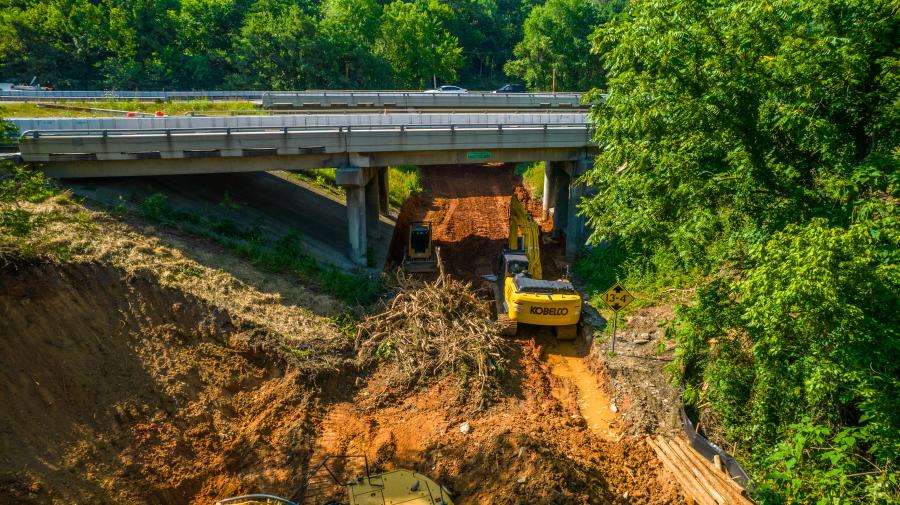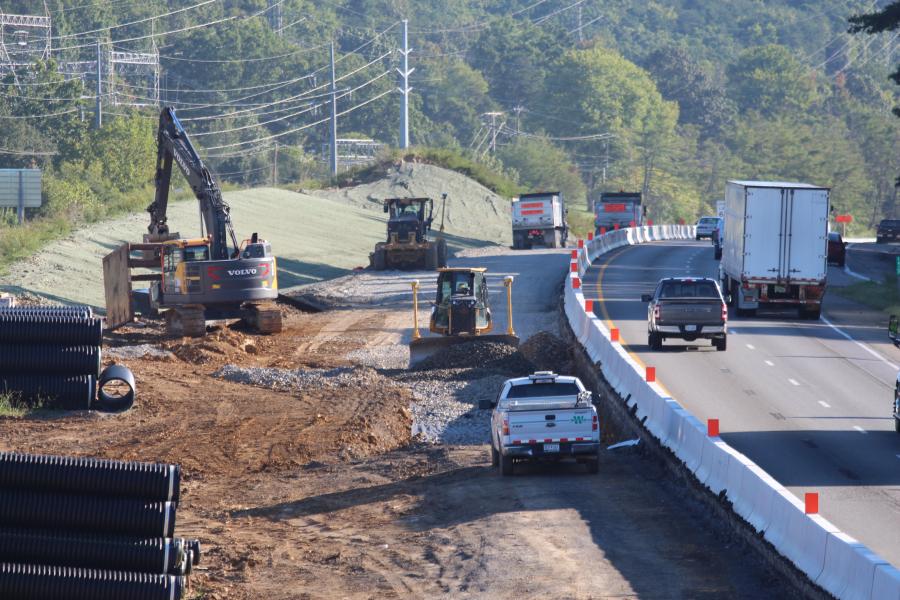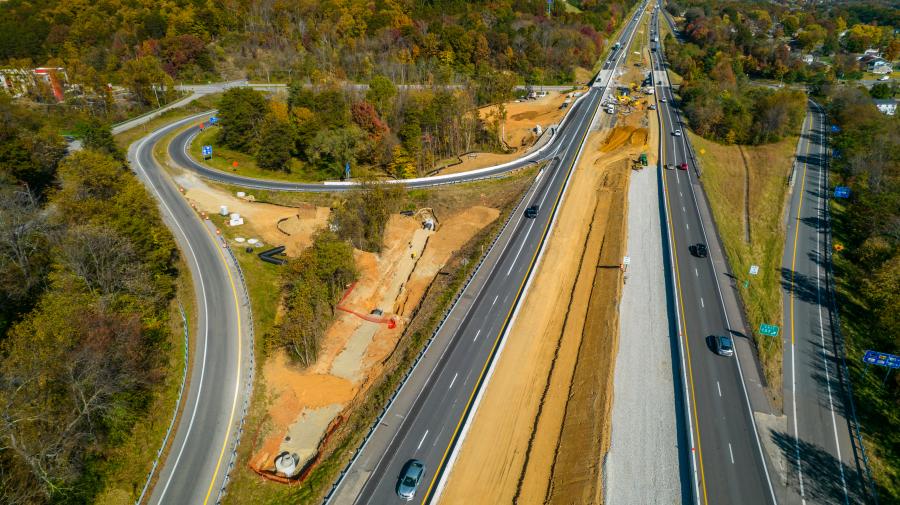Route 635 had to be lowered more than a foot to provide sufficient clearance for the two new I-81 bridges.
(Photo courtesy of Virginia DOT/Archer Western.)
Interstate 81 slashes 325 mi. across western Virginia along the foothills of the Appalachian Mountains. This major traffic corridor is used by local drivers, truckers and visitors to major public universities in the state like James Madison, University of Virginia and Virginia Tech. Built more than 65 years ago, I-81 struggles with capacity and congestion and is in need of expansion.
Virginia DOT (VDOT) has launched a nearly $3 billion program called I-81 Corridor Improvement Program. Buoyed by the passing of a regional fuel tax in 2019, VDOT has begun projects to improve capacity and safety along this important route.
The interstate section between Troutville and Christiansburg is particularly needy. VDOT kicked off the work in 2022 with a project that will add a third lane in each direction between exits 137 and 141. This 4-mi. section is in Salem and Roanoke County. Between 2016 and 2019, this section was the site of more than 300 crashes. Traffic volumes average approximately 65,000 vehicles per day, with nearly one quarter heavy trucks.
This design-build project will be handled by Archer Western of Herndon, Va. Project planners expect it to be completed by 2026 at a cost of $179 million.
VDOT expects that the work will increase capacity, lower crash rates and enable quicker response to crashes and incidents. In addition to widening the freeway, workers will rebuild or widen bridges and make several safety improvements:
- Replace bridges over Routes 112, Route 635 and Route 619;
- Widen bridges over Route 311 at exit 140;
- Build 2.6 mi. of sound barrier walls along the northbound lanes;
- Install concrete barrier walls along narrow median sections; and
- Add interchange lighting, improve acceleration and deceleration lanes where needed.
Dave Covington is program delivery director for the corridor improvements. He has assembled a team that includes Duane Mann of VDOT and Jeff Mays, project manager of Archer Western.
"So far, our progress has been excellent," said Covington. "In the initial phases, traffic has been pushed to the outside lanes with much of the construction happening in the median," said Mann. "The outside shoulders were strengthened in addition to the new lanes being added. The team has been performing earthwork, drainage installations and structural work on bridges."
Covington emphasized the need for the upgrade to I-81.
"Design standards were different back when the interstates were first built," he said. "Traffic has increased dramatically. Many bridges need work, especially since the national standard for bridge height is now 16 feet, six inches. Bridge hits have become more frequent for the older bridges. When those hits happen, the potential impacts to drivers can be significant because we have to close lanes to make the repairs."
The project will require approximately 240,000 tons of asphalt and 24,000 cu. yds. of concrete. The contractor team of Archer Western will need to move more than 300,000 cu. yds. of dirt and rock for the work.
The new lanes will be standard asphalt construction with a subgrade and middle layer, topped by an asphalt finish layer. An unusual aspect of the construction is that the mix may include up to 30 percent recycled asphalt pavement (RAP), which is a higher percentage than most states allow. VDOT studies have shown that this percentage of RAP results in large cost savings with the roads performing well.
Mays and his team are complying with regulations and working to minimize erosion and protect wetlands.
"We took an unusual step of purchasing a 75-acre site to as a laydown and storage area," said Mays. "This property is an abandoned mine site with open environmental permit violations. We will use surplus material from the project to rectify the permit violations."
Long-Lasting Bridges
VDOT wants the new bridges to last a long time. With that goal in mind, Archer Western has been aggressive about keeping water away from sensitive bridge elements by using jointless bridge technology.
"We also are trying to protect the bridges from the corrosion of salt treatments that are used in the winter," said Mays. "In addition, we tested the surrounding soils and determined that some areas were highly acidic and have taken measures to design foundations that will resist these soils over time."
Sometimes more expensive components can end up costing VDOT less in the long term.
"For some of the steel elements we are using stainless steel, which can be two to three times more expensive as regular steel," said Mays. "But we know it will give the bridges a longer life."
Archer Wester proposed several innovations that will enhance safety and reduce congestion.
"We are planning to use message boards to alert drivers about incidents or work zones that will affect their travel," said Mays. "Other message boards have been installed to alert drivers before entering I-81 so they can take alternate routes if necessary."
Safety remains paramount to VDOT and contractors on projects of this nature.
"We are committed to maintain a paved shoulder to facilitate emergency vehicle response during incidents," said Covington. Archer Western supports this approach and also has a dedicated safety manager on site.
With construction at an estimated 20 percent completion, the team can look forward to the positive impact this project and the ones to follow on I-81 will have for drivers.
"Widening this interstate to three lanes in each direction will be a dramatic change for drivers," said Covington. "Drivers are more comfortable when they have more space. This completed work will mean less congestion, which will keep traffic moving safely and more reliably."
Chuck MacDonald
Chuck MacDonald is an editor, blogger and freelance feature writer whose writing adventures have taken him to 48 states and 10 countries. He has been the editor for magazines on pavement construction, chemicals, insurance and missions. Chuck enjoys bicycling, kayaking and reading. He graduated from the University of Missouri with a degree in journalism. Chuck lives in Annapolis, Md. with his wife Kristen. They have seven grandchildren.
Read more from Chuck MacDonald here.
Today's top stories
























